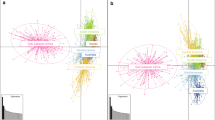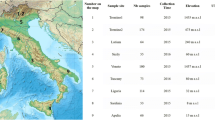Abstract
The genetic structure of natural populations of the economically important dipteran species Ceratitis capitatawas analysed using both biochemical and molecular markers. This revealed considerable genetic variation in populations from different geographic regions. The nature of this variation suggests that the evolutionary history of the species involved the spread of individuals from the ancestral African populations through Europe and, more recently, to Latin America, Hawaii and Australia. The observed variation can be explained by various evolutionary forces acting differentially in the different geographic areas, including genetic drift, bottleneck effects, selection and gene flow. The analysis of the intrinsic variability of the medfly's genome and the genetic relationships among populations of this pest is a prerequisite for any control programme.
Similar content being viewed by others
References
Back, E.A. &; C.E. Pemberton, 1918. The Mediterranean fruit fly. USDA Bulletin 640, US Department of Agriculture, Washington DC: 1–44.
Baruffi, L., G. Damiani, C.R. Gugliemino, C. Bandi, A.R. Malacrida &; G. Gasperi, 1995. Polymorphism within and between populations of Ceratitis capitata: comparison between RAPD and multilocus enzyme electrophoresis data. Heredity 74: 425–437.
Bonizzoni, M., A.R. Malacrida, C.R. Guglielmino, L.M. Gomulski, G. Gasperi &; L. Zheng, 2000. Microsatellite polymorphism in the Mediterranean fruit fly, Ceratitis capitata. Insect Mol. Biol. 9: 251–261.
Bonizzoni, M., L. Zheng, C.R. Gugliemino, D.S. Haymer, G. Gasperi, L.M. Gomulski &; A.R. Malacrida, 2001. Microsatellite analysis of medfly bioinfestations in California. Mol. Ecol. 10: 2515–2524.
Carey, J.R., 1991. Establishment of the Mediterranean fruit fly in California. Science 253: 1369–1373.
Cayol, J.P., 2000. World-wide sexual compatibility in the Med-fly, Ceratitis capitata(Wied.), and its implication for SIT, pp. 657–665 in Area-Wide Control of Fruit Flies and Other Insect Pests, edited by K.H. Tan. Penerbit Universiti Sains Malaysia, Pulau Pinang, Malaysia.
Cirio, U., 1974. Basi ecologiche per un programma di lotta contro Ceratitis capitataWied. nell'isola di Procida. Redia 55: 189–201.
Clark, A.G. &; C.M.S. Lanigan, 1993. Prospects for estimating nucleotide divergence with RAPDs. Mol. Biol. Evol. 10: 1096–1111.
Cournet, J.-M., S. Piry, G. Luikart, A. Estoup &; M. Solignac, 1999. New methods employing multilocus genotypes to select or exclude populations as origins of individuals. Genetics 153: 1989–2000.
Davies, N., F.X. Villablanca &; G.K. Roderick, 1999. Bioinvasions of the medfly Ceratitis capitata: source estimation using DNA sequence at multiple intron loci. Genetics 153: 351–360.
De Breme, F., 1842. Note sur le genre Ceratitisde M. Mac Heay (Diptera). Ann. Soc. Entomol. France 11: 183–190.
Enkerlin, D., L.R. Garcia &; M. Fidel Lopez, 1989. Mexico, Central and south America, pp. 83–90 in Fruit Flies: Their biology, Natural Enemies and Control, Vol. 3A, edited by A.S. Robinson &; G. Hooper. Elsevier Science Publ., Amsterdam, Netherlands.
Fimiani, P., 1989. Mediterranean region, pp. 39–50 in Fruit Flies: Their Biology, Natural Enemies and Control, Vol. 3A, edited by A.S. Robinson &; G.H. Hooper. Elsevier Science Publ., Amsterdam, Netherlands.
Fletcher, B.S., 1989. Movements of tephritid fruit flies, pp. 209–219 in Fruit Flies: Their Biology, Natural Enemies and Control, Vol. 3B, edited by A.S. Robinson &; G.H. Hooper. Elsevier Science Publ., Amsterdam, Netherlands.
Gallo, D.N.O., F.M. Wiendel, S.S. Neto &; P.L.C. Ricardo, 1970. Manual de entomologia. Agronomica Ceres, San Paolo.
Gasperi, G., C.R. Guglielmino, A.R. Malacrida &; R. Milani, 1991. Genetic variability and gene flow in geographical populations of Ceratitis capitata(Wied.) (medfly). Heredity 67: 347–356.
Gilbert, D.A., N. Lehman, S.J. O'Brien &; R.K. Wayne, 1990. Genetic fingerprinting reflects population differentiation in the California Channel Island fox. Nature 344: 764–767.
Gomulski, L.M., C. Torti, A.R. Malacrida &; G. Gasperi, 1997. Ccmar1, a full length marinerelement from the Mediterranean fruit fly, Ceratitis capitata. Insect Mol. Biol. 6: 241–253.
Gomulski, L.M., K. Bourtzis, S. Brogna, P.A. Morandi, C. Bonvicini, F. Sebastiani, C. Torti, C.R. Gugliemino, C. Savakis, G. Gasperi &; A.R. Malacrida, 1998. Intron size polymorphism of the Adh1 gene parallels the worldwide colonization history of the Mediterranean fruit fly, Ceratitis capitata. Mol. Ecol. 7: 1729–1741.
Hagen, K.S., W.W. William &; R.L. Tassan, 1981. The Mediterranean fruit fly: the worst may be yet to come. Calif. Agric. 35: 5–7.
Harris, E.J., 1989. Hawaiian islands and North America, pp. 73–81 in Fruit Flies: Their Biology, Natural Enemies and Control, Vol. 3A, edited by A.S. Robinson &; G.H. Hooper. Elsevier Science Publ., Amsterdam, Netherlands.
Haymer, D.S., M. He &; D.O. McInnis, 1997. Genetic marker analysis of spatial and temporal relationships among existing populations of the Mediterranean fruit fly. Heredity 79: 302–309.
He, M. &; D.S. Haymer, 1999. Genetic relationships of populations and the origins of the new infestations of the Mediterranean fruit fly. Mol. Ecol. 8: 1247–1257.
Hooper, G.H.S. &; R.A.I. Drew, 1989. Australia and South Pacific islands, pp. 67–72 in Fruit Flies: Their Biology, Natural Enemies and Control, Vol. 3A, edited by A.S. Robinson &; G.H. Hooper. Elsevier Science Publ., Amsterdam, Netherlands.
Huettel, M., P.A. Fuerst, M. Maruyama &; R. Chakraborty, 1980. Genetic effects of multiple populations bottlenecks in the Mediterranean fruit fly (Ceratitis capitata). Genetics 94s: 47–48 (abstract).
Joint FAO/IAEA Division, 1980. Report of the Consultants' Meeting on: A Genetic SexingMechanism for theMediterranean Fruit Fly, Ceratitis capitata. International Atomic Agency, Vienna, Austria.
Joint FAO/IAEA Division, 1985. Report of the Consultants' Meeting on: The Application of Genetics Engineering and Recombinant DNA Technology in the Development of Genetic Sexing Mechanisms for the Mediterranean Fruit Fly, Ceratitis capitata(Wied.). International Atomic Agency, Vienna, Austria.
Kidwell, M.G., 1989. Evolutionary aspects of hybrid dysgenesis in Drosophila. Can. J. Zool. 68: 1716–1726.
Kimura, M., 1983. The Natural Theory of Molecular Evolution. Cambridge University Press, Cambridge.
Lynch, M., 1990. The similarity index and DNA fingerprinting. Mol. Biol. Evol. 7: 478–484.
Maddison, P.A. &; B.J. Barlett, 1989. Contribution towards the zoogeography of the Tephritidae, pp. 27–35 in Fruit Flies: Their Biology, Natural Enemies and Control, Vol. 3A, edited by A.S. Robinson &; G.H. Hooper. Elsevier Science Publ., Amsterdam, Netherlands.
Malacrida, A.R., G. Gasperi, L. Baruffi &; R. Milani, 1990. The contribution of formal genetic studies to the species characterization of Ceratitis capitata(Wied.), pp. 85–89 in Genetic Sexing of the Mediterranean Fruit Fly. International Atomic Agency Press, Vienna, Austria.
Malacrida, A.R., C.R. Guglielmino, G. Gasperi, L. Baruffi &; R. Milani, 1992. Spatial and temporal differentiation in colonizing populations of Ceratitis capitata. Heredity 69: 101–111.
Malacrida, A.R., F. Marinoni, C. Torti, L.M. Gomulski, F. Sebastiani, C. Bonvicini, G. Gasperi &; C.R. Guglielmino, 1998. Genetic aspects of the worldwide colonization process of Ceratitis capitata. J. Hered. 89: 501–507.
McPheron, B.A., W.S. Sheppard &; G.J. Steck, 1995. Genetic research and the origin, establishment, and the spread of the Mediterranean fruit fly, pp. 93–107 in The Medfly in California: Defining Critical Research, edited by J.G. Morse, R.L. Metcalf &; R.V. Dowell. Center for Exotic Pest Research, University of California, Riverside.
The Cooler, Newsletter of Medfly Germoplasm Repository, Vol. 3, pp. 1–8. Medfly Germoplasm Repository (ed), 1995. USDA, APHIS, Otis, USA.
Morse, J.G. &; R.V. Dowell, 1998. Proceedings of the Exotic Fruit Fly Research Symposium, edited by J.G. Morse &; R.V. Dowell. College of Natural and Agricultural Sciences, University of California, Riverside.
Myers, J., D. Simberloff, A.M. Kuris &; J.R. Carey, 2000. Eradication revisited: dealing with exotic species. Trends Ecol. Evol. 15: 316–320.
Nei, M., 1987. Molecular Evolutionary Genetics. Columbia University Press.
Nei, M., T. Maruyama &; R. Chakraborty, 1975. The bottleneck effect and genetic variability in populations. Evolution 29: 1–10.
Rannala, B. &; J.L. Mountain, 1997. Detecting immigration using multilocus genotypes. Proc. Natl. Acad. Sci. USA 94: 9197–9201.
Robinson, A.S. &; G. Hooper (eds), 1989. Fruit Flies: Their Biology, Natural Enemies and Control, Vol. 3A, pp. 1–371; Vol. 3B, pp. 1–445. Elsevier Science Publ., Amsterdam, The Netherlands.
Sheppard, W.S., G.J. Steck &; B.A. McPheron, 1992. Geographic populations of the medflymay be differentiated by mitochondrial DNA variation. Experientia 48: 1010–1013.
Siebert, J.A., 1994. Economic impact of an embargo by Japan, Korea, Taiwan and Hong Kong of selected California exports due to aMediterranean fruit fly infestation. Dept. Agric. and Res. Econom., University of California, Berkeley.
Simberloff, D., 1997. Eradication, pp. 221–228 in Strangers in Paradise: Impact and Management of Nonindigenous Species in Florida, edited by Simberloff et al. Island Press.
Slatkin, M., 1985. Rare alleles as indicators of gene flow. Evolution 39: 53–65.
Slatkin, M., 1987. Gene flow and the geographic structure of natural populations. Science 236: 787–792.
Torti, C., A.R. Malacrida, G. Yannopoulos, C. Louis &; G. Gasperi, 1994. Hybrid dysgenesis-like phenomena in the medfly, Ceratitis capitata(Diptera, Tephritidae). J. Hered. 85: 92–99.
Torti, C., L.M. Gomulski, A.R. Malacrida, P. Capy &; G. Gasperi, 1997. Genetic and molecular investigations on the endogenous mobile elements of non-drosophilid fruitflies. Genetica 100: 119–129.
Torti, C., L.M. Gomulski, A.R. Malacrida, P. Capy &; G. Gasperi, 1998. Characterization and evolution of marinerelements from closely related species of fruit flies (Diptera: Tephritidae). J.Mol. Evol. 46: 288–298.
Torti, C., L.M. Gomulski, D. Moralli, E. Raimondi, H.M. Robertson, P. Capy, G. Gasperi &; A.R. Malacrida, 2000. Evolution of different subfamilies of marinerelements within the medfly genome inferred from abundance and chromosomal distribution. Chromosoma 108: 523–532.
Villablanca, F.X., G.K. Roderick &; S.R. Palumbi, 1998. Invasion genetics of the Mediterranean fruit fly: variation in multiple nuclear introns. Mol. Ecol. 7: 547–560.
Author information
Authors and Affiliations
Rights and permissions
About this article
Cite this article
Gasperi, G., Bonizzoni, M., Gomulski, L. et al. Genetic Differentiation, Gene Flow and the Origin of Infestations of the Medfly, Ceratitis Capitata . Genetica 116, 125–135 (2002). https://doi.org/10.1023/A:1020971911612
Issue Date:
DOI: https://doi.org/10.1023/A:1020971911612




